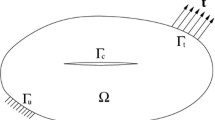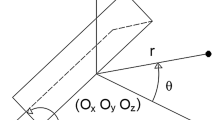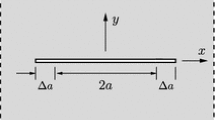Abstract
Crack propagation and fatigue fracture is studied with an enriched meshless method. This method uses an intrinsic enrichment of the meshless weighting functions such that the correct crack kinematics can be described. The major advantage of the method is its simplicity, especially with respect to implementation. The method is applied to problems in elastostatics where analytical and experimental data is available. We show the higher accuracy of our method in comparison to standard methods for two problems with analytical solutions. Finally, we show the accuracy of the method for interacting flaws.
Similar content being viewed by others
References
Kobelev V (2006) Micropolar model of fracture for composite material. Meccanica 41:653–660
Uddin FAKM, Shigeishiand M, Ohtsu M (2006) Fracture mechanics of corrosion cracking in concrete by acoustic emission. Meccanica 41:425–442
Carloni C, Piva A, Viola E (2004) Biaxial load effect on crack initiation for orthotropic materials. Meccanica 39:331–344
Zhou ZG, Chen YC, Wang B (2000) Analysis of two collinear cracks in a piezoelectric layer bonded to two half spaces subjected to anti-plane shear. Meccanica 35:443–456
Tong P, Pian THH (1973) On the convergence of the finite element method for problems with singularity. Int J Solids Struct 9:313–321
Gallagher RH (1978) A review of finite element techniques in fracture mechanics. In: Luxmoore AR, Owen DRJ (eds) Proceedings of the 1st international conference on numerical methods in fracture mechanics, Swansea, Pineridge, pp 1–25
Fawkes AJ, Owen DRJ, Luxmoore AR (1979) An assessment of crack tip singularity models for use with isoparametric elements. Eng Fract Mech 11:143–159
Fawkes AJ, Owen DRJ (1983). Engineering fracture mechanics: numerical methods and applications
Liebowitz H, Moyer ET (1989) Finite element methods in fracture mechanics. Comput Struct 31:1–9
Belytschko T, Lu YY (1995) Element-free Galerkin methods for static and dynamic fracture. Int J Solids Struct 32:2547–2570
Belytschko T, Tabbara M (1996) Dynamic fracture using element-free Galerkin methods. Int J Numer Methods Eng 39(6):923–938
Liu WK, Hao S, Belytschko T (1999) Multiple scale meshfree methods for damage fracture and localization. Comput Mater Sci 16(1–4):197–205
Rabczuk T, Belytschko T (2006) Application of particle methods to static fracture of reinforced concrete structures. Int J Fract 137:19–49
Li S, Hao W, Liu WK (2000) Mesh-free simulations of shear banding in large deformation. Int J Solids Struct 37:7185–7206
Hao S, Liu WK, Qian D (2000) Localization-induced band and cohesive model. J Appl Mech Trans ASME 67(4):803–812
Hao S, Liu WK, Klein PA, Rosakis AJ (2004) Modeling and simulation of intersonic crack growth. Int J Solids Struct 41(7):1773–1799
Li S, Liu WK, Rosakis A, Belytschko T, Hao W (2002) Mesh free Galerkin simulations of dynamic shear band propagation and failure mode transition. Int J Solids Struct 39:1213–1240
Randles PW, Libersky LD (1997) Recent improvements in sph modeling of hypervelocity impact. Int J Impact Eng 20:525–532
Hao S, Liu WK, Chang CT (2000) Computer implementation of damage models by finite element and meshfree methods. Comput Methods Appl Mech Eng 187(3–4):401–440
Randles PW, Libersky L (2000) Normalized sph with stress points. Int J Numer Methods Eng 48:1445–1461
Han ZD, Liu HT, Rajendran AM, Atluri SN (2007) The applications of meshless local Petrov-Galerkin (mlpg) approaches in high-speed impact, penetration and perforation problems. Comput Model Eng Sci 14:119–128
Rabczuk T, Belytschko T, Xiao SP (2004) Stable particle methods based on Lagrangian kernels. Comput Methods Appl Mech Eng 193:1035–1063
Rabczuk T, Eibl J (2003) Simulation of high velocity concrete fragmentation using sph/mlsph. Int J Numer Methods Eng 56:1421–1444
Hao S, Liu WK (2006) Moving particle finite element method with superconvergence: Nodal integration formulation and applications. Comput Methods Appl Mech Eng 195(44–47):6059–6072
Belytschko T, Lu YY, Gu L (1995) Crack propagation by element-free Galerkin methods. Eng Fract Mech 51(2):295–315
Organ D, Fleming M, Terry T, Belytschko T (1996) Continuous meshless approximations for nonconvex bodies by diffraction and transparency. Comput Mech 18:225–235
Liu HT, Han ZD, Rajendran AM, Atluri SN (2006) Computational modeling of impact response with the rg damage model and the meshless local Petrov-Galerkin (mlpg) approaches. Comput Mater Contin 4:43–53
Rabczuk T, Belytschko T (2004) Cracking particles: a simplified meshfree method for arbitrary evolving cracks. Int J Numer Methods Eng 61(13):2316–2343
Rabczuk T, Belytschko T (2005) Adaptivity for structured meshfree particle methods in 2d and 3d. Int J Numer Methods Eng 63(11):1559–1582
Rabczuk T, Belytschko T (2007) A three-dimensional large deformation meshfree method for arbitrary evolving cracks. Comput Methods Appl Mech Eng 196(29–30):2777–2799
Rabczuk T, Areias PMA, Belytschko T (2007) A meshfree thin shell method for non-linear dynamic fracture. Int J Numer Methods Eng 72(5):524–548
Rabczuk T, Areias P (2006) A meshfree thin shell for arbitrary evolving cracks based on an extrinsic basis. Comput Model Eng Sci 16(2):115–130
Fleming M, Chu YA, Moran B, Belytschko T (1997) Enriched element-free Galerkin methods for crack tip fields. Int J Numer Methods Eng 40:1483–1504
Ventura G, Xu J, Belytschko T (2002) A vector level set method and new discontinuity approximation for crack growth by efg. Int J Numer Methods Eng 54(6):923–944
Rabczuk T, Zi G (2007) A meshfree method based on the local partition of unity for cohesive cracks. Comput Mech 39(6):743–760
Rabczuk T, Areias PMA, Belytschko T (2007) A simplified mesh-free method for shear bands with cohesive surfaces. Int J Numer Methods Eng 69:993–1021
Zi G, Rabczuk T, Wall W (2007) Extended meshfree methods without branch enrichment for cohesive cracks. Comput Mech 40:367–382
Belytschko T, Lu YY, Gu L (1994) Element-free Galerkin methods. Int J Numer Methods Eng 37:229–256
Melenk JM, Babuska I (1996) The partition of unity finite element method: basic theory and applications. Comput Methods Appl Mech Eng 139:289–314
Strouboulis T, Copps K, Babuska I (2000) The generalized finite element method: an example ofits implementation and illustration of its performance. Int J Numer Methods Eng 47:1401–1417
Moran B, Shih CF (1987) Crack tip and associated domain integrals from momentum and energy balance. Eng Fract Mech 27(6):615–641
Yau JF, Wang SS, Corten HT (1980) A mixed mode crack analysis of isotropic solids using conservation laws of elasticity. J Appl Mech 47:335–341
Murakami Y (1987) Stress intensity factors handbook. Pergamon, Oxford
Hasegawa K, Miyazaki K (2007) Crack propagation in the presence of shot-peening residual-stresses. Key Eng Mater 345–346:411–416
Tu ST, Cai RY (1988) A coupling of boundary elements and singular integral equation for the solution of the fatigue cracked body. In: Brebbia CA (ed) Boundary elements X. Stress analysis, vol 3. Springer, Berlin, pp 239–247
Author information
Authors and Affiliations
Corresponding author
Additional information
Because of the regrettable behavior of the author (Professor Gunter Hildebrand) the paper “Fracture analysis using an enriched meshless method” DOI 10.1007/s11012-008-9189-4 has been withdrawn, since the paper is a fraud and its content and results are copied from another manuscript. Apologies are due to Dr Duflot who emphasized the plagiarism of the Hildebrand paper with his paper: A meshless method with enriched weight functions for fatigue crack growth Marc Duflot and Hung Nguyen-Dang (2004) International Journal for Numerical Methods in Engineering 59:1945-1961. We have tried to obtain an explanation from Professor Hildebrand on this matter, but did not receive any reply from him. Since we have not received a proper note from Professor Hildebrand, and considering the communications of Dr Duflot, Meccanica preferred to withdraw the paper in order to prevent an illicit spread of the paper itself.




